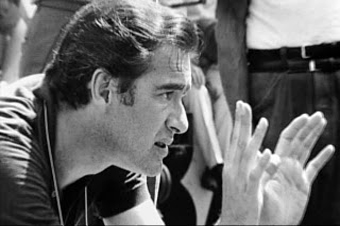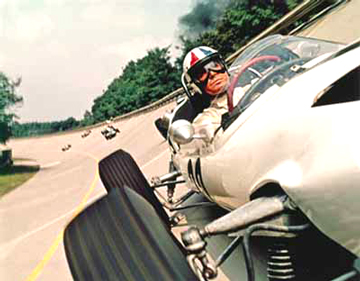
 |
|
|
|
A major car culture epic, John Frankenheimer's Grand Prix is unique among 1960s Roadshow spectacles. Director Frankenheimer had veered into the realm of political and technological fantasy with the increasingly paranoid trio of The Manchurian Candidate, Seven Days in May and Seconds. Much of this racing saga plays as a contrasting exercise in logistics and technique, much like Frankenheimer's The Train, where Burt Lancaster played smash-up with real French railway hardware. Grand Prix posed a man's (or boy's) challenge: To capture the thrills of top-level Formula One racing in a way that puts the audience right into the driver's seat. Indeed, perhaps the most relevant dialogue line in the "dramatic" part of the movie is when Eva Marie Saint turns to Yves Montand and observes that the racetrack spectators don't seem to get a very good look at the action. Grand Prix does one thing exceedingly well, and that's give each viewer the experience of zooming down a track at 180 mph, in a car barely larger than a bathtub. 
Robert Alan Arthur's sprawling screenplay alternates races with soap opera dramatics. At Monaco, Jordan-BRM teammate Scott Stoddard (Brian Bedford) has a near-fatal accident for which he faults American Pete Aron (James Garner), a driver noted for being too aggressive. Scott is sidelined to recover, a disability his wife Pat (Jessica Walter) uses to start an affair with Pete. Meanwhile, sponsor-less Pete is forced to become a TV reporter until Japanese racing boss Izo Yamura (Toshirô Mifune) hires him to drive again -- but only if Aron pulls out all stops to win. French racer Jean-Pierre Sarti (Yves Montand) is at an age where he's tired of racing and fed up with his bad marriage to Monique (Geneviève Page); he takes up with American photojournalist Louise Frederickson (Eva Marie Saint). And Jean-Pierre's Sicilian teammate Nino Barlini (Antonio Sabàto) enjoys himself with a quick racetrack pickup, Lisa (Françoise Hardy). The roller coaster thrills of This is Cinerama! are outpaced by impressive technical ingenuity in the mechanical, yet thrilling Grand Prix. The film might well be titled Grand Camera Mounts, as the most arresting images come from 65mm cameras rigged right on the moving race cars. Besides giving us a dizzying blur of motion on the Super Panavision 70 screen (Super Cinerama in Cinerama ® theaters), the camera can pan from a sideways view of the driver to a forward view looking over the right front tire. On a big screen, the experience is like being strapped onto a rocket. On the steep banking of the Monza race course the car-mounted camera remains level while the car tilts 40° to one side. In theaters one could observe the entire audience tilting their heads and laughing in wonder. This viewer participation phenomenon could very well have inspired Stanley Kubrick and/or Douglas Trumbull to come up with the Star Gate slit-scan "trip" in 2001: A Space Odyssey. The Special Edition's featurettes and docus detail the means by which Frankenheimer achieved his specific racing effects. Several of his actors were car enthusiasts or had racing experience so we're frequently treated to real shots of James Garner or Yves Montand blazing through the curves. Expert editing and some acceptable split-screen work add to the effect, aided by dizzying helicopter shots that twist with the cars as they negotiate the streets of Monaco. Grand Prix expends most of Frankenheimer's tricks in the first twenty-minute racing scene, and succeeding races are either abbreviated or augmented with visual themes. For one race, Maurice Jarre's music takes over and Saul Bass's split-screen visuals give us a soft-focus reverie of racing images. Another concentrates on telephoto shots of spectators. 
Aviation pictures provided the template for earlier racing films: give 'em one big action scene at the beginning, another at the end, and fill the middle with montages. Executive producer Kirk Douglas made a Fox film called The Racers in 1955; its "big crash" in the opening race happens when somebody's French poodle wanders onto the rece course! Other racing car movies tend toward melodramatic plots, with drivers avenging the deaths of martyred brothers or going berserk on the track while competing for the attentions of the leading lady. The most ridiculous example is a Clark Gable show about midget car racing, To Please a Lady. Just seeing Gable crammed into his tiny, inconsequential-looking speedster is hilarious. Grand Prix labors nobly to dramatize the love lives of its racing car drivers. We have two illicit affairs, a driver obsessed with living up to the legacy of his dead brother, an aging warrior trapped between an unforgiving wife (Geneviève Page of The Private Life of Sherlock Holmes) and a domineering boss (Adolfo Celi), an ambitious American and a jet-setting Sicilian swinger. Frankenheimer does his best to apply a glitzy continental glaze over these personal complications but is defeated by a basic rule of blockbuster filming: it all has to be in English. Thus we're deprived of the Formula One circuit's multilingual European atmosphere. Even in their native languages newcomers Antonio Sabàto and Françoise Hardy aren't great actors and appear to have been coached like chimpanzees. Their dialogue scenes flatline for everything except Hardy's "I don't dance, I don't drink ..." come-on tease. Yves Montand already proved his incompatibility with English in the Marilyn Monroe movie Let's Make Love. He gets by but forfeits most of his natural charm and individuality, and Eva Marie Saint must work overtime to keep their scenes alive. Jessica Walter lacks the effortless Euro-glamour needed for her role, and must interact with more dubbed Frenchmen like Claude Dauphin. Brian Bedford is the most interesting character, but his dramatic scenes invariably end with a snappy line before anything really insightful transpires. Frankenheimer relies far too often on "meaningful" looks to cap his dramatic scenes. Of the four drivers James Garner comes off the best, even though he has the worst language problem, talking to Toshirô Mifune. Mifune's entire performance is dubbed by Paul Frees, and not well. It's like talking to the host voice at the Disneyland Haunted House, or the narrator in The St. Valentine's Day Massacre. 
Grand Prix's only message is that racers race for the same reason mountain climbers climb. It's an existential riddle. Lovers are reunited or disillusioned, fortunes rise and fall. Although the movie never becomes boring, the bedroom drama never takes hold. At the finale James Garner stands alone on the vast empty track, an image that cruel critics took as a metaphor for the film as a whole. We almost expect Garner to give us a Naked City benediction, something like "There are only one or two workable stories in the Big World of Grand Prix racing. This wasn't one of them." Yet those unforgettable racetrack scenes are real grabbers, something not likely to be matched in these days of CGI, where only low budget movies consider filming real action with real cars and real people. Warner Home Video's Blu-ray of Grand Prix appears to come from the same master as their excellent 2007 DVD release (which actually retailed at a dollar more than this Blu-ray). The bright and sharp transfer is accompanied by 5.1 tracks in English and Spanish, and a mono track in French. It was transferred from 65mm elements; a few hairline scratches and marred frames show up here and there. We love Maurice Jarre's score but his single march-waltz theme gets old after the two-hour mark, especially when played by Oom-pah-pah marching bands. The film's exact length is a mystery. Some reference books list 179 minutes without overture and ent'racte music, but this disc's official running time is 176. Since this transfer is supposed to be from the 70mm Roadshow version we don't expect it to be cut. Perhaps MGM snipped the film by a few minutes when they recalled it to revoice Toshirô Mifune's vocal track. A second disc contains four well-researched docus that concentrate on the making-of story, with chapters covering the historical racing context, the movie's superb soundtrack (authentic racing sounds add immeasurably to the film's effect) and the race courses themselves. James Garner convinces us that he's really mad, when a store owner in Monaco holds up a shot over a payment issue. The actor shouts at the Frenchman that he's freezing his tail off waiting in the water, and the man sure as hell better get out of the way! A fluffy featurette from 1966 does its best to make us think that all of the filming was done at actual races! Fans of Grand Prix -- you know who you are -- will be snapping this disc up.
On a scale of Excellent, Good, Fair, and Poor,
Grand Prix Blu-ray rates:
Reviews on the Savant main site have additional credits information and are often updated and annotated with reader input and graphics. Also, don't forget the 2010 Savant Wish List. T'was Ever Thus.
Review Staff | About DVD Talk | Newsletter Subscribe | Join DVD Talk Forum |
| ||||||||||||||||||